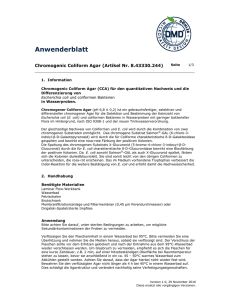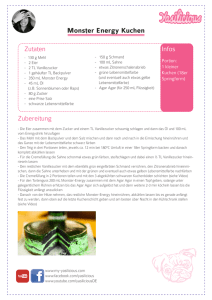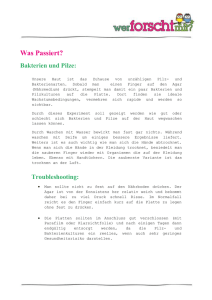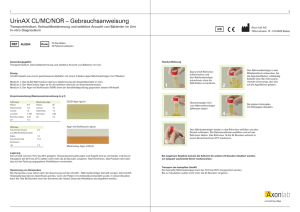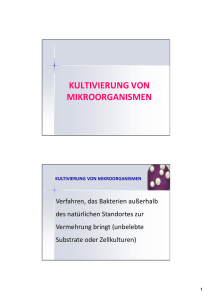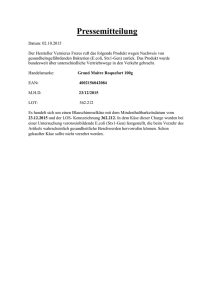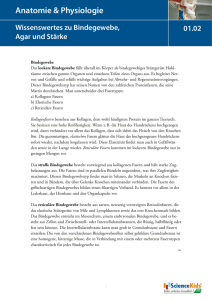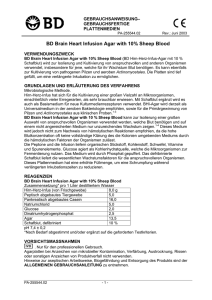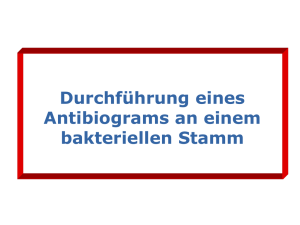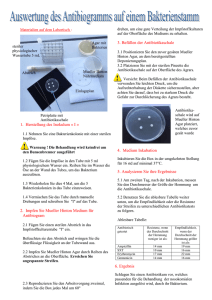Gebrauchsanweisung EN
Werbung
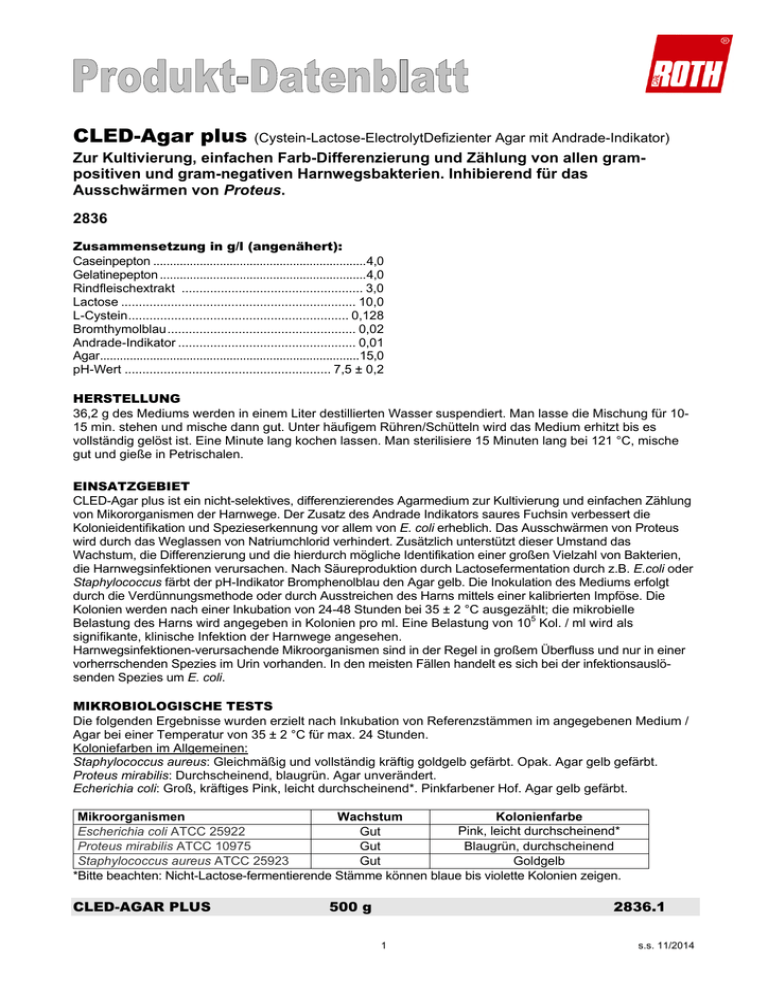
CLED-Agar plus (Cystein-Lactose-ElectrolytDefizienter Agar mit Andrade-Indikator) Zur Kultivierung, einfachen Farb-Differenzierung und Zählung von allen grampositiven und gram-negativen Harnwegsbakterien. Inhibierend für das Ausschwärmen von Proteus. 2836 Zusammensetzung in g/l (angenähert): Caseinpepton ................................................................4,0 Gelatinepepton ..............................................................4,0 Rindfleischextrakt ................................................... 3,0 Lactose .................................................................. 10,0 L-Cystein .............................................................. 0,128 Bromthymolblau ..................................................... 0,02 Andrade-Indikator .................................................. 0,01 Agar..............................................................................15,0 pH-Wert .......................................................... 7,5 ± 0,2 HERSTELLUNG 36,2 g des Mediums werden in einem Liter destillierten Wasser suspendiert. Man lasse die Mischung für 1015 min. stehen und mische dann gut. Unter häufigem Rühren/Schütteln wird das Medium erhitzt bis es vollständig gelöst ist. Eine Minute lang kochen lassen. Man sterilisiere 15 Minuten lang bei 121 °C, mische gut und gieße in Petrischalen. EINSATZGEBIET CLED-Agar plus ist ein nicht-selektives, differenzierendes Agarmedium zur Kultivierung und einfachen Zählung von Mikororganismen der Harnwege. Der Zusatz des Andrade Indikators saures Fuchsin verbessert die Kolonieidentifikation und Spezieserkennung vor allem von E. coli erheblich. Das Ausschwärmen von Proteus wird durch das Weglassen von Natriumchlorid verhindert. Zusätzlich unterstützt dieser Umstand das Wachstum, die Differenzierung und die hierdurch mögliche Identifikation einer großen Vielzahl von Bakterien, die Harnwegsinfektionen verursachen. Nach Säureproduktion durch Lactosefermentation durch z.B. E.coli oder Staphylococcus färbt der pH-Indikator Bromphenolblau den Agar gelb. Die Inokulation des Mediums erfolgt durch die Verdünnungsmethode oder durch Ausstreichen des Harns mittels einer kalibrierten Impföse. Die Kolonien werden nach einer Inkubation von 24-48 Stunden bei 35 ± 2 °C ausgezählt; die mikrobielle Belastung des Harns wird angegeben in Kolonien pro ml. Eine Belastung von 105 Kol. / ml wird als signifikante, klinische Infektion der Harnwege angesehen. Harnwegsinfektionen-verursachende Mikroorganismen sind in der Regel in großem Überfluss und nur in einer vorherrschenden Spezies im Urin vorhanden. In den meisten Fällen handelt es sich bei der infektionsauslösenden Spezies um E. coli. MIKROBIOLOGISCHE TESTS Die folgenden Ergebnisse wurden erzielt nach Inkubation von Referenzstämmen im angegebenen Medium / Agar bei einer Temperatur von 35 ± 2 °C für max. 24 Stunden. Koloniefarben im Allgemeinen: Staphylococcus aureus: Gleichmäßig und vollständig kräftig goldgelb gefärbt. Opak. Agar gelb gefärbt. Proteus mirabilis: Durchscheinend, blaugrün. Agar unverändert. Echerichia coli: Groß, kräftiges Pink, leicht durchscheinend*. Pinkfarbener Hof. Agar gelb gefärbt. Mikroorganismen Wachstum Kolonienfarbe Pink, leicht durchscheinend* Escherichia coli ATCC 25922 Gut Blaugrün, durchscheinend Proteus mirabilis ATCC 10975 Gut Goldgelb Staphylococcus aureus ATCC 25923 Gut *Bitte beachten: Nicht-Lactose-fermentierende Stämme können blaue bis violette Kolonien zeigen. CLED-AGAR PLUS 500 g 2836.1 1 s.s. 11/2014 CLED Agar plus (Cysteine Lactose Electrolyte Deficient Agar plus Andrade’s indicator) For cultivation, easy differentiation by colour and enumeration of gram-positive and gram-negative bacteria from the urinary tract. Inhibits swarming of Proteus. 2836 Approximate formula in g/l: Casein peptone .............................................................4.0 Gelatine peptone ...........................................................4.0 Beef extract ............................................................. 3.0 Lactose .................................................................. 10.0 L-Cysteine ............................................................ 0.128 Bromothymol blue .................................................. 0.02 Andrade’s indicator ................................................ 0.01 Agar..............................................................................15.0 Final pH ........................................................ 7.5 ± 0.2 PREPARATION Suspend 36.2 g of the medium in one liter of distilled or deionized water. Soak for 10-15 mins. and mix well. Heat with frequent agitation until complete dissolution. Boil for one minute and sterilize at 121 ºC for 15 minutes. Mix well and pour intro Petri dishes. USES CLED agar is a non selective, differential plating medium for the growth and enumeration of microorganisms of the urinary tract. Addition of the Andrade’s indicator acidic fuchsin improves colony and species identification significantly, particularly for E. coli. Swarming of Proteus is inhibited by omitting sodium chloride. Additionally, this enhances the growth of the great majority of bacteria causing urinary tract infections, supporting their differentiation and, subsequently, identification. Due to acid production based on lactose fermentation by e.g. E.coli or Staphylococcus, the pH indicator bromophenol blue stains the agar yellow. Inoculation of the medium can be performed by dilution method or by streaking the agar surface with a calibrated loop. Colonies are counted after 24 – 48 hours incubation at 35 ± 2 °C and microbial count is reported as colonies per ml urine. A count of 105 col. / ml is referred to as a significant clinical infection of the urinary tract. Microorganisms causing infection of the urinary tract are generally abundant of one species only. Most frequently, E. coli is identified as the major component of these infections. MICROBIOLOGICAL TEST The following results were obtained in the performance of the given medium from type cultures after incubation at a temperature of 35 ± 2 °C and observed after max. 24 hours. Colony colours in general: Staphylococcus aureus: Even bright golden yellow. Opaque. Yellow agar. Proteus mirabilis: Translucent, blue-green. Agar unchanged. Echerichia coli: large, bright pink*. Semi-translucent. Surrounding pink halo. Yellow agar. Microorganisms (test strains) Growth Escherichia coli ATCC 25922 Good Proteus mirabilis ATCC 10975 Good Staphylococcus aureus ATCC 25923 Good *Note: Non lactose fermenting strains may show blue to violet colonies. CLED-AGAR PLUS 500 g Colony Colour pink, semi-translucent* blue green, translucent golden yellow 2836.1 Carl Roth GmbH + Co. KG Schoemperlenstraße 3-5 _ 76185 Karlsruhe Postfach 100121 _ 76231 Karlsruhe Telefon: +49 (0) 721/5606-0 _ Telefax: +49 (0) 721/5606-149 E-Mail: [email protected] _ Internet: www.carlroth.de 2 s.s. 11/2014
